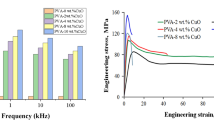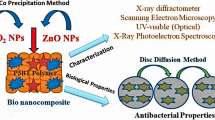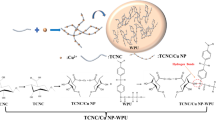Abstract
Due to its good biodegradability and biocompatibility, polycaprolactone (PCL) has attracted widespread attention in the field of biomedical materials. Incorporation of Zinc oxide (ZnO) into PCL has been proved an effective way to improve its antibacterial properties. However, the interfacial compatibility of the organic-inorganic system needs to be improved due to the agglomeration of nanoparticles and phase separation of ZnO and PCL matrix affect its antibacterial efficiency. In this research, the ZnO surface was modified with citric acid monohydrate (CA) to improve the interfacial properties of ZnO-PCL system. The surface modification of ZnO was analyzed by DLS, TEM, TGA, and XPS. The results suggest that CA coating process can significantly reduce the agglomeration of ZnO nanoparticles and improve dispersion stability. The uniform PCL/ZnO-CA membranes with various nanofiller contents were fabricated through the solvent casting method. DSC and TGA analysis showed that the presence of ZnO-CA nanoparticles slightly decreased the crystallinity and thermal stability of the polymer. And ZnO-CA loaded improved the mechanical properties and wettability of the composite PCL membranes. Moreover, the composite PCL membranes showed good antibacterial activity against both E. coli and S. aureus while exhibiting good cytocompatibility, which indicated that the antibacterial and no cytotoxicity biomaterials had promising application in the biomedical field.








Similar content being viewed by others
References
Woodruff MA, Hutmacher DW (2010) The return of a forgotten polymer-Polycaprolactone in the 21st century. Prog Polym Sci 35(10):1217–1256
Wang Y, Cui W, Zhao X et al (2018) Bone remodeling-inspired dual delivery electrospun nanofibers for promoting bone regeneration. Nanoscale 11(1):60–71
Sattary M, Khorasani MT, Rafienia M et al (2018) Incorporation of nanohydroxyapatite and vitamin D3 into electrospun PCL/gelatin scaffolds: the influence on the physical and chemical properties and cell behavior for bone tissue engineering. Polym Adv Technol 29(1):451–462
Ding Y, Li W, Correia A et al (2018) Electrospun Polyhydroxybutyrate/poly(epsilon-caprolactone)/sol-gel-derived silica hybrid scaffolds with drug releasing function for bone tissue engineering applications. ACS Appl Mater Interfaces 10(17):14540–14548
Kim Y-J, Park MR, Kim MS et al (2012) Polyphenol-loaded polycaprolactone nanofibers for effective growth inhibition of human cancer cells. Mater Chem Phys 133(2–3):674–680
Sakka S, Baroudi K, Nassani MZ (2012) Factors associated with early and late failure of dental implants. J Investig Clin Dent 3(4):258–261
Schwartz-Arad D, Laviv A, Levin L (2008) Failure causes, timing, and cluster behavior: an 8-year study of dental implants. Implant Dent 17(2):200–203
Lee C-H, Chung YS, Lee SH et al (2012) Analysis of the factors influencing bone graft infection after cranioplasty. J Trauma Acute Care Surg 73(1):255–260
Aros-Calt S, Castelli FA, Lamourette P et al (2019) Metabolomic Investigation of Staphylococcus aureus Antibiotic Susceptibility by Liquid Chromatography Coupled to High-Resolution Mass Spectrometry. Methods Mol Biol 1871:279–293
Tra Thanh N, Ho Hieu M, Tran Minh Phuong N et al (2018) Optimization and characterization of electrospun polycaprolactone coated with gelatin-silver nanoparticles for wound healing application. Mater Sci Eng C Mater Biol Appl 91:318–329
Yi Z, Wei H, Jiehua L et al (2017) Gemini quaternary ammonium salt waterborne biodegradable polyurethanes with antibacterial and biocompatible properties. Mater Chem Front 1(2):361–368
Leng M, Hu S, Lu A et al (2016) The anti-bacterial poly(caprolactone)-poly(quaternary ammonium salt) as drug delivery carriers. Appl Microbiol Biotechnol 100(7):3049–3059
Lumbreras-Aguayo A, Melendez-Ortiz HI, Puente-Urbina B et al (2019) Poly(methacrylic acid)-modified medical cotton gauzes with antimicrobial and drug delivery properties for their use as wound dressings. Carbohydr Polym 205:203–210
Sokmen M, Tatlidil I, Breen C et al (2011) A new nano-TiO2 immobilized biodegradable polymer with self-cleaning properties. J Hazard Mater 187(1–3):199–205
Prabhawathi V, Sivakumar PM, Boobalan T et al (2019) Design of antimicrobial polycaprolactam nanocomposite by immobilizing subtilisin conjugated Au/Ag core-shell nanoparticles for biomedical applications. Mater Sci Eng C Mater Biol Appl 94:656–665
Chen P, Wu Z, Leung A et al (2018) Fabrication of a silver nanoparticle-coated collagen membrane with anti-bacterial and anti-inflammatory activities for guided bone regeneration. Biomed Mater 13(6):065014
Fernandez-Calderon MC, Cifuentes SC, Pacha-Olivenza MA et al (2017) Antibacterial effect of novel biodegradable and bioresorbable PLDA/Mg composites. Biomed Mater 12(1):015025
Tong WY, Bin Abdullah AYK, Rozman NASB et al (2018) Antimicrobial wound dressing film utilizing cellulose nanocrystal as drug delivery system for curcumin. Cellulose 25(1):631–638
Nair S, Sasidharan A, Rani VVD et al (2009) Role of size scale of ZnO nanoparticles and microparticles on toxicity toward bacteria and osteoblast cancer cells. J Mater Sci Mater Med 20:235–241
Ye JY, Huang ZY, Min C et al (2009) Structure and haemocompatibility of ZnO films deposited by radio frequency sputtering. Biomed Mater 4(5):055004
Perez Espitia PJ, Ferreira Soares NDF, Dos Reis Coimbra JS et al (2012) Zinc oxide nanoparticles: synthesis, antimicrobial activity and food packaging applications. Food Bioprocess Technol 5(5):1447–1464
Felice B, Sanchez MA, Socci MC et al (2018) Controlled degradability of PCL-ZnO nanofibrous scaffolds for bone tissue engineering and their antibacterial activity. Mater Sci Eng C Mater Biol Appl 93:724–738
Leal AI, Caridade SG, Ma J et al (2013) Asymmetric PDLLA membranes containing bioglass (R) for guided tissue regeneration: characterization and in vitro biological behavior. Dent Mater 29(4):427–436
DING Y, Li W, Muller T et al (2016) Electrospun Polyhydroxybutyrate/poly(epsilon-caprolactone)/58S sol-gel bioactive glass hybrid scaffolds with highly improved Osteogenic potential for bone tissue engineering. ACS Appl Mater Interfaces 8(27):17098–17108
Zhang Z, Tang J, Wang H et al (2015) Controlled antibiotics release system through simple blended electrospun fibers for sustained antibacterial effects. ACS Appl Mater Interfaces 7(48):26400–26404
Zou J, Jiang X, Zhang J et al. Preparation and Characterization of Surface-modified B-tricalcium Phosphate/Ploy (L-lactide) Biocomposites, New and Advanced Materials, Pts 1 and 2, 2011: 120–126
Jiang L, Xiong C, Chen D et al (2012) Effect of n-HA with different surface-modified on the properties of n-HA/PLGA composite. Appl Surf Sci 259:72–78
Sadlo A, Peeters D, Albert R et al (2019) Investigating zinc Ketoiminates as a new class of precursors for solution deposition of ZnO thin films. J Nanosci Nanotechnol 19(2):867–876
Stevens JS, Byard SJ, Schroeder SLM (2010) Characterization of proton transfer in co-crystals by X-ray photoelectron spectroscopy (XPS). Cryst Growth Des 10(3):1435–1442
Ribut SH, Abdullah CAC, Mustafa M et al (2019) Influence of pH variations on zinc oxide nanoparticles and their antibacterial activity. Mater Res Expr 6(2):E015016
Mallakpour S, Javadpour M (2018) Comprehensive study on reinforcement of poly(vinyl chloride) nanocomposite films with ZnO nanoparticles modified by citric acid and vitamin C. Int J Polym Anal Charact 23(5):415–429
Liao J-G, Zhang L, Zuo Y et al (2009) Surface modification of Nano-hydroxyapatite with stearic acid. Chinese J Inorg Chem 25(7):1267–1273
Messali M, Alwadaani F, Oudghiri-Hassani H et al (2014) Preparation, characterization and photocatalytic activity of hexagonal ZnO nanoparticles. Mater Lett 128:187–190
Ding Y, Roether JA, Boccaccini AR et al (2014) Fabrication of electrospun poly (3-hydroxybutyrate)/poly (epsilon-caprolactone)/silica hybrid fibermats with and without calcium addition. Eur Polym J 55:222–234
Mallakpour S, Nouruzi N (2017) Effects of citric acid-functionalized ZnO nanoparticles on the structural, mechanical, thermal and optical properties of polycaprolactone nanocomposite films. Mater Chem Phys 197:129–137
Jiang Y, Mao K, Cai X et al (2011) Poly(ethyl glycol) assisting water sorption enhancement of poly(epsilon-caprolactone) blend for drug delivery. J Appl Polym Sci 122(4):2309–2316
Abdolmaleki A, Mallakpour S, Borandeh S (2014) Tailored functionalization of ZnO nanoparticle via reactive cyclodextrin and its bionanocomposite synthesis. Carbohydr Polym 103:32–37
Min BM, Jeong L, Nam YS et al (2004) Formation of silk fibroin matrices with different texture and its cellular response to normal human keratinocytes. Int J Biol Macromol 34(5):281–288
Yu W, Lan C-H, Wang S-J et al (2010) Influence of zinc oxide nanoparticles on the crystallization behavior of electrospun poly(3-hydroxybutyrate-co-3-hydroxyvalerate) nanofibers. Polymer 51(11):2403–2409
Vishnu Chandar J, Shanmugan S, Murugan P et al (2016) Structural analysis of ZnO nanoparticles reinforced P(3HB-co-15 Mol% 3HHx) bioplastic composite. J Polym Environ 25(4):1251–1261
Pires LSO, Fernandes MHFV, De Oliveira JMM (2018) Crystallization kinetics of PCL and PCL–glass composites for additive manufacturing. J Therm Anal Calorim 134(3):2115–2125
Celebi H, Bayram G, Dogan A (2013) Effect of ZnO type and concentration on the mophology, thermal, and mechanical properties of poly(ether ester)/ZnO composites. J Appl Polym Sci 129(6):3417–3424
Samad UA, Alam MA, Chafidz A et al (2018) Enhancing mechanical properties of epoxy/polyaniline coating with addition of ZnO nanoparticles: Nanoindentation characterization. Prog Org Coat 119:109–115
Mallakpour S, Nouruzi N (2016) Modification of morphological, mechanical, optical and thermal properties in polycaprolactone-based nanocomposites by the incorporation of diacid-modified ZnO nanoparticles. J Mater Sci 51(13):6400–6410
Mu S, Wu D, Qi S et al (2011) Preparation of Polyimide/Zinc Oxide Nanocomposite Films via an Ion-Exchange Technique and Their Photoluminescence Properties. J Nanomater
Ramier J, Bouderlique T, Stoilova O et al (2014) Biocomposite scaffolds based on electrospun poly(3-hydroxybutyrate) nanofibers and electrosprayed hydroxyapatite nanoparticles for bone tissue engineering applications. Mater Sci Eng C Mater Biol Appl 38:161–169
Augustine R, Malik HN, Singhal DK et al (2014) Electrospun polycaprolactone/ZnO nanocomposite membranes as biomaterials with antibacterial and cell adhesion properties. J Polym Res 21(3)
Lim CT, Tan EPS, Ng SY (2008) Effects of crystalline morphology on the tensile properties of electrospun polymer nanofibers. Appl Phys Lett 92(14)
Yeo M, Lee H, Kim G (2011) Three-dimensional hierarchical composite scaffolds consisting of Polycaprolactone, beta-Tricalcium phosphate, and collagen Nanofibers: fabrication, physical properties, and in vitro cell activity for bone tissue regeneration. Biomacromolecules 12(2):502–510
Venugopal J, Low S, Choon AT et al (2008) Electrospun-modified nanofibrous scaffolds for the mineralization of osteoblast cells. J Biomed Mater Res A 85A(2):408–417
Si J, Cui Z, Wang Q et al (2016) Biomimetic composite scaffolds based on mineralization of hydroxyapatite on electrospun poly(epsilon-caprolactone)/nanocellulose fibers. Carbohydr Polym 143:270–278
Song W, Mano JF (2013) Interactions between cells or proteins and surfaces exhibiting extreme wettabilities. Soft Matter 9(11):2985
Gong M, Chi C, Ye J et al (2018) Icariin-loaded electrospun PCL/gelatin nanofiber membrane as potential artificial periosteum. Colloids Surf B: Biointerfaces 170:201–209
Liu Y, Shen X, Zhou H et al (2016) Chemical modification of chitosan film via surface grafting of citric acid molecular to promote the biomineralization. Appl Surf Sci 370:270–278
Patil PP, Bohara RA, Meshram JV et al (2019) Hybrid chitosan-ZnO nanoparticles coated with a sonochemical technique on silk fibroin-PVA composite film: A synergistic antibacterial activity. Int J Biol Macromol 122:1305–1312
Sirelkhatim A, Mahmud S, Seeni A et al (2015) Review on zinc oxide nanoparticles: antibacterial activity and toxicity mechanism. Nano Micro Lett 7(3):219–242
Acknowledgements
The project is support by the Fundamental Research Funds for the Central Universities (grant Nos. 2232019A3-06, 2232018G-01), Science and Technology Support Program of Shanghai (grant Nos. 16441903803, 18441902600) and 111 project 2.0 (grant No. B07024).
Author information
Authors and Affiliations
Corresponding authors
Additional information
Publisher’s note
Springer Nature remains neutral with regard to jurisdictional claims in published maps and institutional affiliations.
Electronic supplementary material
ESM 1
(DOCX 13058 kb)
Rights and permissions
About this article
Cite this article
Liu, L., Zhang, Y., Li, C. et al. Facile preparation PCL/ modified nano ZnO organic-inorganic composite and its application in antibacterial materials. J Polym Res 27, 78 (2020). https://doi.org/10.1007/s10965-020-02046-z
Received:
Accepted:
Published:
DOI: https://doi.org/10.1007/s10965-020-02046-z




